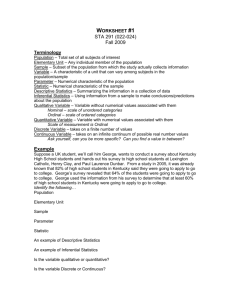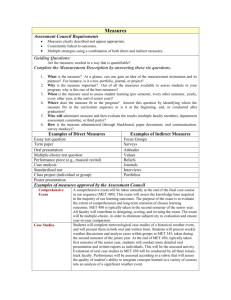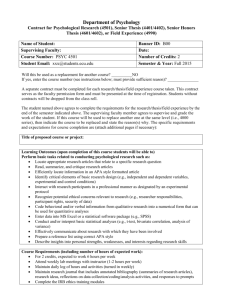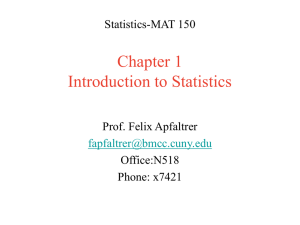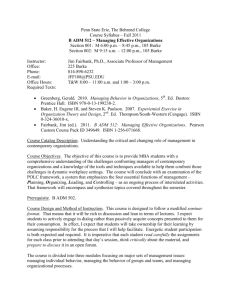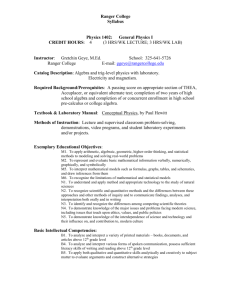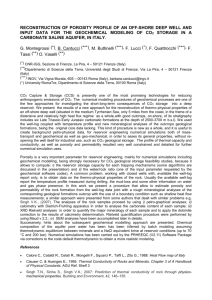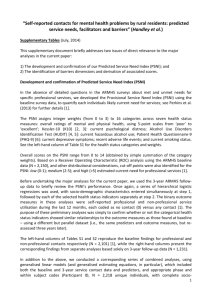Elementary Statistical Methods Course Syllabus
advertisement
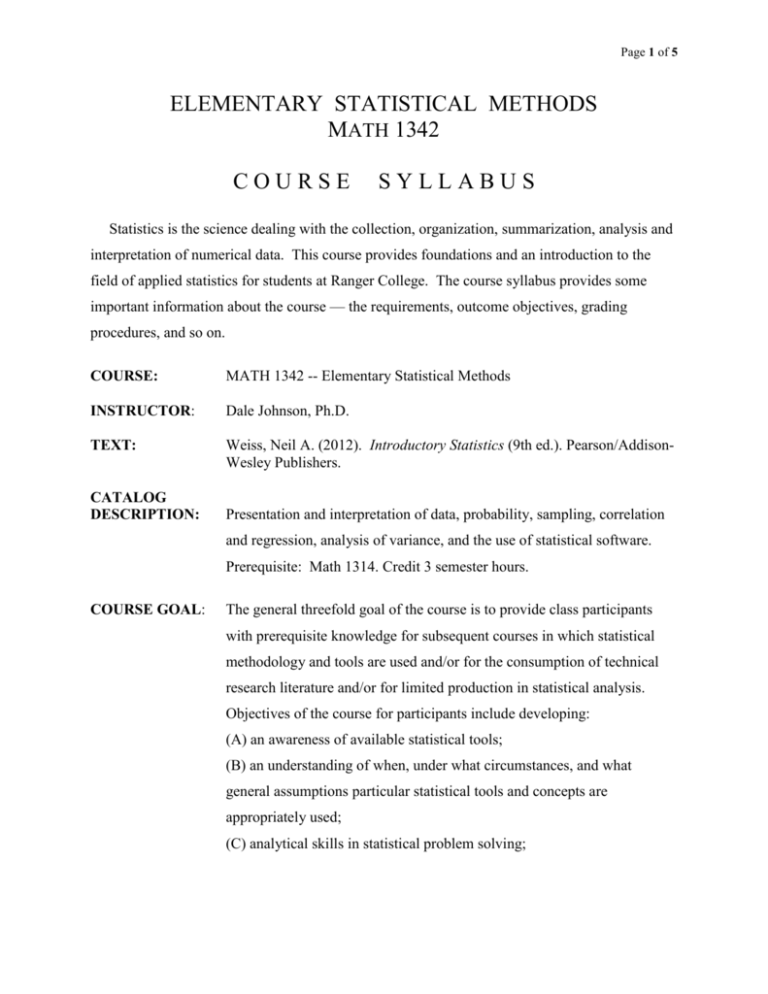
Page 1 of 5 ELEMENTARY STATISTICAL METHODS MATH 1342 COURSE SYLLABUS Statistics is the science dealing with the collection, organization, summarization, analysis and interpretation of numerical data. This course provides foundations and an introduction to the field of applied statistics for students at Ranger College. The course syllabus provides some important information about the course — the requirements, outcome objectives, grading procedures, and so on. COURSE: MATH 1342 -- Elementary Statistical Methods INSTRUCTOR: Dale Johnson, Ph.D. TEXT: Weiss, Neil A. (2012). Introductory Statistics (9th ed.). Pearson/AddisonWesley Publishers. CATALOG DESCRIPTION: Presentation and interpretation of data, probability, sampling, correlation and regression, analysis of variance, and the use of statistical software. Prerequisite: Math 1314. Credit 3 semester hours. COURSE GOAL: The general threefold goal of the course is to provide class participants with prerequisite knowledge for subsequent courses in which statistical methodology and tools are used and/or for the consumption of technical research literature and/or for limited production in statistical analysis. Objectives of the course for participants include developing: (A) an awareness of available statistical tools; (B) an understanding of when, under what circumstances, and what general assumptions particular statistical tools and concepts are appropriately used; (C) analytical skills in statistical problem solving; Page 2 of 5 (D) the knowledge for interpreting descriptive and inferential statistical results; (E) skills for critical consumption of statistical data from literature; (F) competencies in analysis of data; and (G) a more positive attitude toward quantitative problem-solving issues; ACTIVITIES: Basically, expect to become conversant with the common terminology of statistics; be introduced to various conceptual frameworks of statistics while examining computational aspects, application, and interpretation of statistical analysis; and become conversant with measurement (numeric scaling), quantitative research design, and associated data analyses. While this course does not dwell on computer analysis (this is a statistics class), students can expect to perform numerical analyses via the computer and other available technology. GRADING: >1/3rd of the final grade will be based on periodic homework assignments >1/3rd of the final grade will be based on 3 hour exams >1/3rd of the final grade will be based on the final exam Homework, hour exams, and the final exam scores will be averaged and grades will be assigned according to the scale below: Performance* Assigned Grade 90 - 100 points or be in the top 25% of the class...................A 80 - 89 points or be in the top 50% of the class.....................B 70 - 79 points or be in the top 75% of the class.....................C 60 - 69 points or be in the top 90% of the class.....................D Below 60 points and be in the bottom 10% of the class.........F *Class ranking used only for classes of 20 or more students; otherwise, grades will be assigned by points. SCHEDULE This course is offered during the Fall semester on Monday and Wednesday from 1:20 - 2:35. Attendance is strongly encouraged. Page 3 of 5 INFORMATION: Hand-held calculators are permissible (in fact, encouraged) for class use. If you do not have a calculator, it is recommended that you secure an inexpensive calculator to perform simple arithmetic operations and to extract square roots. While statistical procedures will be permissible using Excel or other computer software, some pedagogical strategies call for limited simple hand calculations. Students who have access to SPSS, SAS, Statistica, or other software are encouraged to learn the procedures to perform statistical analyses with these more sophisticated platforms. Statistical analyses will be an expectation throughout the duration of the course. It is the policy of Ranger to comply with the Americans with Disabilities Act and other applicable laws. If you are a student with a disability seeking accommodations for this course, please contact administrative offices charged with Student Disability Services designated in the college Catalog. Students may identify themselves to the instructor at any time throughout the semester. CONTENT: The course emphasizes basic statistical concepts as well as manipulation of data and normally includes the following topics: Descriptive Statistics Introduction to the Field of Statistics Displaying Data Frequency and Relative Frequency Distributions Summarizing Data: Measures of Central Tendency Summarizing Data: Measures of Dispersion Numerical Scaling: Describing Individual Performances Probability Elementary Probability Events Probability as Relative Frequency Common Probability Distributions Inferential Statistics Estimation and Confidence Intervals Page 4 of 5 Hypothesis Testing – p-values and α-level Bivariate Correlation and Regression t-Test Models Single Classification Analysis of Variance Tentative Class Schedule ( the pace may be modified if warranted) (Chapter references to the textbook are expected to be read/studied before the corresponding date.) Lesson Number January 13 Introduction/Orientation/Overview of the Course 1 January 15 Chapter 1 2 January 20 Chapter 2: 2.1, 2.2, & 2.3 3 January 22 Chapter 2: 2.4 & 2.5 4 January 27 Chapter 3: 3.1 & 3.2 5 January 29 Chapter 3: 3.3 6 February 3 Chapter 3: 3.4 7 February 5 Contingency & Review 8 February 10 Hour Quiz #1 (Open book, open note exam) 9 February 12 Chapter 4: 4.1, 4.2, & 4.3 10 February 17 Chapter 4: 4.4, 4.5, & 4.6 11 February 19 Chapter 5: 5.1, 5.2, & 5.3 12 February 24 Chapter 6: 6.1, 6.2 13 February 26 Chapter 6: 6.3, 6.4 & 6.5 14 March 3 Class Problem Session/Review 15 March 5 Hour Quiz #2 (Open book, open note exam) 16 March 10 Spring Break (No Class) N/A March 12 Spring Break (No Class) N/A March 17 Chapter 7 17 March 19 Chapter 8 18 March 24 Chapter 9: 9.1, 9.2 & 9.3 19 March 26 Chapter 9: 9.4 & 9.5 20 March 31 Chapter 10: 10.1 & 10.2 21 Page 5 of 5 Lesson Number (continued) April 2 Chapter 10: 10.3 & 10.5 22 April 7 Chapter 16: 16.1, 16.2 23 April 9 Chapter 16: 16.3 & 16.4 24 April 14 Review 25 April 16 Quiz #3 (Open book, open note) 26 April 21 Chapter 14: 14.1 & 14.2 27 April 23 Chapter 14: 14.3 & 14.4 28 April 28 Chapter 15: 15.1 & 15.2 29 April 30 Chapter 15: 15.3 & 15.4 30 May 5 Review 31 May 7 Cumulative Final Exam (Open book, open note) 32

